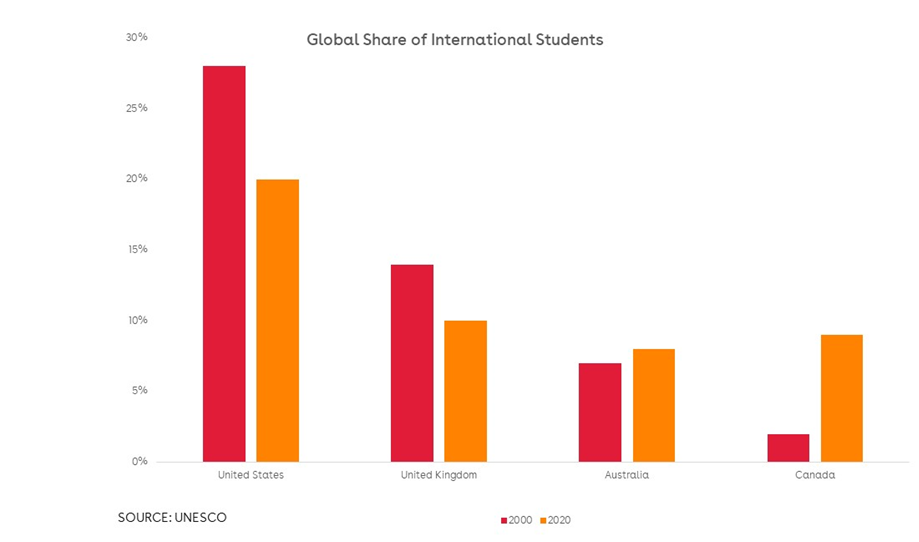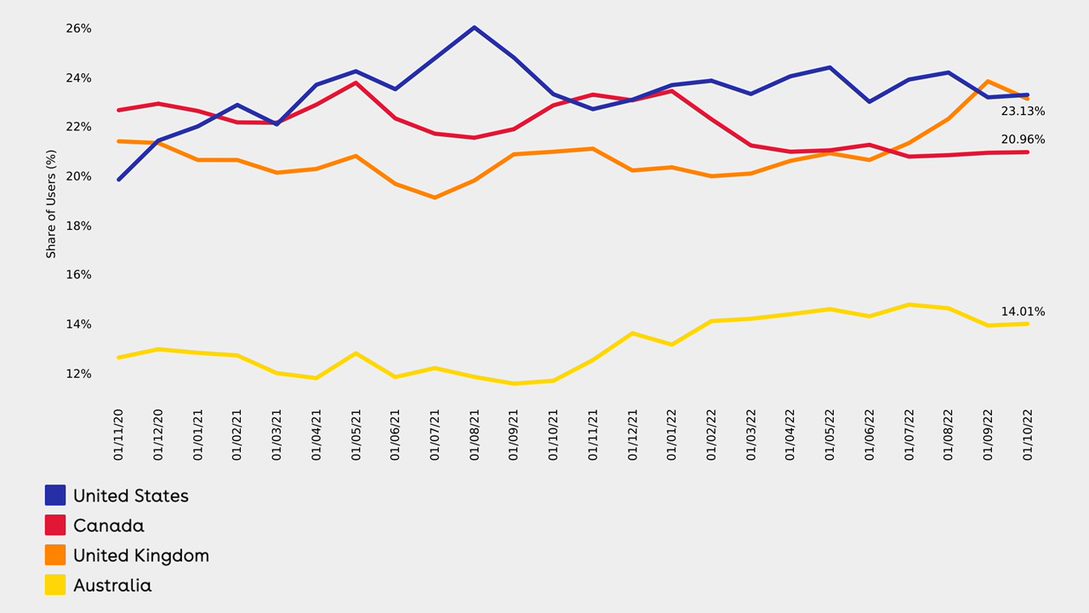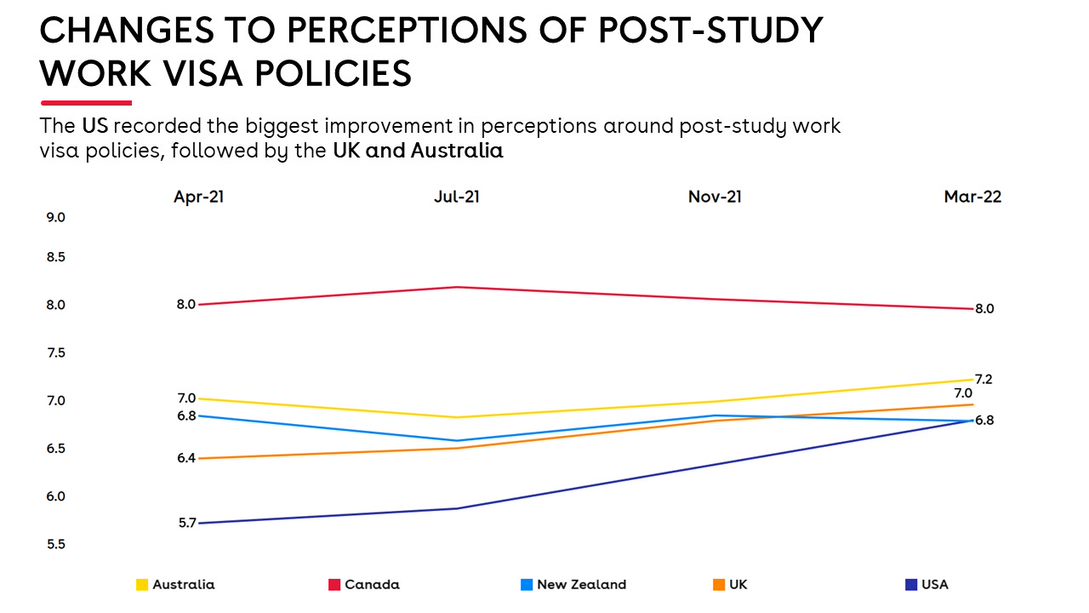As many institutions are aware, and as IDP data shows, the post-Covid rebound is well and truly on track in the international education sector –demand is very strong. How did we get here, what are the policies and micro and macro factors driving the current student trends, and what impact did Covid have? In this article, we take a look at the global sector to see what the data can tell us.
Our Emerging Futures II research has revealed that, currently, quality of education and strong employment outcomes are key drivers in education choices for prospective international students.
Our focus groups and data analysis show us that demand may be negatively impacting certain processes, service levels and strategic choices made by institutions but, overall, student experience is still well rated.
So, we are facing a welcome boom-time, which means that efficient processes, effective outcomes, and maintaining student satisfaction are key to ensuring a study destination does not lose out. However, that data also shows that we are in a time of increased competition, when all the major destination countries have positive policies, and often national strategies, to drive forward and grow their international numbers.
Here we look at how the big four study destinations have responded to the pandemic and how their current policy strategies relate to international students.
How has policy affected the market and what are the strategies for recovery?
In the two decades prior to 2020, the US and UK lost out significantly to numerous other destinations as international students shopped around for new study and living opportunities. Despite Australian gains, Canada increased its market share to overtake Australia in the sector.
By 2020, Canada was the third most popular study destination, behind the US and UK with both top destinations experiencing lower international student uptake.

Now, our IQ Demand tool reveals that in January 2023 the US has the most interest as a potential study destination (on 1 January, 24.12%of students on our websites were viewing US institutions/courses). Canada is slightly ahead of UK with 21.3% and 20.48% interest respectively. Australia sits fourth with 14.28%. It is intriguing to note that interest in the US underwent an almost uninterrupted ascent from January 2021 when President Biden was inaugurated, before reaching a peak in August 2021 around the time when Biden halted construction of the border wall with Mexico and made sweeping immigration reforms. This ascent coincided with a loss of interest for Canada and the UK.
However, in September 2022, when Boris Johnson’s term as Prime Minister ended, interest in the UK as a study destination increased to a significant peak, but interest in the UK is now at its lowest since July 2021 when the UK Government lifted a number of the final COVID-19 restrictions (including the reopening of nightclubs).
While we know from past experience and research that students have strong reactions to these types of macro political events and the associated rhetoric, they may or may not be directly linked to student choice. However, our demand data allows us to track regular peaks and troughs in destination interest and, on occasion, we can presume correlations between world events and student demand.
Destinations Market Demand

As the education sector continues its recovery from the COVID-19 pandemic, fierce global competition among study destinations is developing. Here we look at how policy is helping and hindering in the major destination countries.
Country Responses to COVID-19
Governmental reactions to the COVID-19 pandemic in relation to handling of international students was diverse across the globe, and only now are we seeing how this has affected ongoing student experience and choice.
In Canada, the country remained open to students but with strict conditions and requirements. There was a 14-day pre-departure / post-arrival quarantine requirement for new entrants who were not fully vaccinated, and free vaccinations were available for students in situ.
Australia’s response was more stringent. The country’s borders closed and for a long time there was no clear plan for re-opening. Institutions switched to online learning provision and home country learning hubs set up for international students who were unable to travel into the country.
There was a long period of uncertainty for students heading to the USA, especially early in the pandemic. Policies shifted when the administration changed –prior to the election, a temporary ban on students’ ability to enter the country was put in place and students lost their visa rights if courses were delivered entirely online. After the election, and once the Biden administration was in place, international student travel was reintroduced, albeit with caveats.
The UK introduced a Red List of countries which required students to undergo quarantine on entry, but otherwise it remained open to students. Institutions introduced flexible start dates and hybrid course delivery methods. Free vaccinations were available.
Post-pandemic education policy and the effects on international students
Canada
Canada’s policy on international education sees students as a key part of its wider strategy to build the right population and strong workforce within the country. The availability of Post Graduate Work Permits (PGWPs) is currently tied to the length of the study programme being undertaken, with the potential for 1-3 years of eligibility. This is a strong driving factor for students from South Asia.
International students see Canadian education as a pathway to permanent residence in the country, and there has been significant growth in the sector over the last five years; however, there is an increasing need for diversity away from India, especially within the College sector.
Long delays in student visa processing by the IRCC has also been a well-documented problem which has been focused upon in the press. Our Emerging Futures II respondents also highlighted the issue – 36% said it took more than 10 weeks for their student visa to be processed, making Canada by far the worst performing of the top study destinations (research data gathered May 2022).
Australia
Pre-pandemic, Australia had been experiencing significant growth in student numbers, but the almost two-year closure of its borders to all but citizens and residents undoubtedly caused doubt in the minds of international students, and the country has experienced a 40% drop in overall international placements compared to pre-pandemic levels.
To focus its post-pandemic recovery, Australia is targeting key factors including diversification, meeting skill gaps in the labour market, increased growth and global competitiveness and AUS$1.5million investment in Transnational education (TNE) including new forms of offshore course delivery across North Asia, Southeast Asia, South Asia and LATAM.
The strategy paper says, “The Australian Government will expand opportunities for non-Australian Qualifications Framework courses to be delivered offshore particularly in areas of future skills needs.”*
2022 saw the announcement of new budget allocation (AUS$36 million) for the improvement of visa processing services for international students.
This was followed in February 2023 by the Federal Government seeking to improve skill shortages by announcing post-study work rights extensions for international higher education graduates in Australia. From 1 July 2023, the number of years in which international students can maintain employment in Australia will be extended by two years following course completion, with eligible bachelor's degree graduates now able to stay for four years, eligible master's degree graduates can remain for five years, and eligible PhD graduates can stay for six years. The allowable work hours cap will also increase from 40 hours per fortnight to 48 hours per fortnight.
It’s more positive news for Australia as an international education hub, after IDP’s Emerging Futures II survey (August 2022) ranked Australia in second place as first-choice destination among all student respondents – 25% said it was their first choice (closely behind Canada with 27%). This has improved significantly from the previous survey (March 2022) when it was ranked in joint third spot (alongside the UK) with 19%, behind Canada (27%) and the US (25%).
* Australian Strategy for International Education 2021-2030 Page 12
US
The US has received significant growth in student interest since the ending of community lockdown restrictions and Joe Biden’s presidential election win. An IDP survey of prospective international students revealed that 76% said their perception of the US as a study destination had improved since the change of administration, with 67% saying they are more likely to study in the US as a result. However, since Biden’s inauguration there has been little in the way of overarching governmental policy or strategy to rebuild the international student numbers lost between 2000 and 2020.
Mirroring IQ Demand data, which showed increased interest in the US as a study destination in August 2021, data from IDP’s Emerging Futures II survey (below) showed a similar upswing in relation to changing perceptions of post-study work visa policies. The dramatic rhetoric shift which accompanied the change of administration appears to have caused a notable upswing in international student perceptions of the country in this respect.

Post-study work opportunities are a key driver of student choice, and even though the US is a top global recruiter of international students, it typically lags behind other key destinations in this respect based on perceptions that post-study work opportunity is limited. However, the Optional Practical Training (OPT) program allows recent graduates to work in the US for up to 12 months, and STEM graduates can extend their visa by an additional 24 months. The Department of State has also announced more flexibility in determining non-immigrant intent for F-1 and M-1 student visa applications.
So, growth in student numbers is expected over the next three to five years in the US, but the possibility of another Trump administration may have a negative impact in relation to certain key student choice drivers.
Due to the breadth of its offering, the US remains an ominous presence in the market for competitor destinations, especially as IDP’s Emerging Futures II data shows that perception of the quality of education in the US is the highest of the four main destinations (ranking score of 8.5, with UK ranking at 8.38, and Canada 8.2).
The high costs associated with education in US could be seen as a tempering factor though – the US and UK rank behind Canada when it comes to perceptions of value for money (Canada received a 7.8 rating, US 7.7, and UK 7.61).
UK
The UK experienced a bumper two to three years of student growth largely due to the closure of Australia and uncertainty around US education. A governmental target of attaining 600,000 international students by 2030 was achieved ahead of schedule (452,225 were non-EU students).
There was a 5% fall in the number of Chinese students travelling to the UK, but students from India increased by 27%.
A new immigration route (the Graduate visa route) was created as part of the new points-based immigration system introduced in the UK in July 2021.This route allows international student graduates to stay in the UK for two years following completion of a bachelor’s or master's degree and three years following PhD or other doctoral studies. The visa enables graduates to live in the UK and work in any job, providing time to gain employment that will support a switch to the Skilled Worker visa route. Critics have suggested that the amount of time should be increased to at least three years, as this would help the UK remain competitive in the international education market.
Vivienne Stern, director of Universities UK International, told The Guardian that vice-chancellors wanted the government to review the two-year visa route to determine whether it was “a barrier to employing international graduates”, and if it provided a “competitive post-study work offer”. The Home Secretary at the time, Priti Patel, said that the route gives “the best and brightest graduates the opportunity to continue contributing to the UK’s prosperity and the freedom to kickstart their careers in the UK”.
However, recent comments by Home Secretary Suella Braverman relating to restrictions on the number of students who would be allowed to stay in the UK post-graduation, may well have a negative effect on the country’s student growth plans if enacted.
The UK is now looking to diversify and tailor cohorts and will bank on ongoing student perceptions of its high-quality education offering to enable this. However, with the cost-of-living crisis in full force in the UK, there will be increased competition from other, more-perceptibly affordable destinations, especially as Australia’s changes to post-study work rights and attempts to fulfil certain skills shortages might increase its positive perception rankings. And similarly in Canada, where the possibility of permanent migration is a strong driver, institutions will be seeking diversity in student intake, and the perception of the destination as offering good value for money will be a key action point in its favour over the UK.
IDP student placement data shows pandemic recovery is gaining momentum
In 2022, student placement numbers and English language test-taking volumes have achieved record levels and demonstrate the strong growth in the international education sector. IDP Education has seen:
36% increase in qualified student enquiries when compared to the same period in 2021
45% increase in student placement when compared to the same period in 2021
67% increase in IELTS tests when compared to the same period in 2021
And in terms of the 2021v2022 course enrolment numbers, there have been increases across all major destinations:
USA up 154%
Canada up 50%
Australia up 39%
UK up 36%
It is clear that student demand for studying abroad is, once again, increasing, and that policy makers play an important role in the perceptions of each destination. However, the cost-of-living crisis, which has been largely fueled by the conflict in Ukraine, has meant countries perceived as costly may lose out on student growth unless they are able to provide effective financial support services and advice for students, and market these accordingly.
Managing the boom and maintaining great student experience
While increase in demand for international education is positive, each country’s management of the increase in volume is likely to be key in ongoing student destination choice. In the short-term, focusing on maintaining quality of education and services, as well as providing value for money, must be seen as hugely important for institutions.
Policy regarding post-study work will also be a key driver, and institutions need to be aware of how they can influence potential outcomes for students in this respect. Marketing to the right cohort is more important than ever to fulfil policy needs relating to diversity and skills shortages.
In April we will be publishing our next set of data analysis from Emerging Futures III, so keep your eyes peeled for more insights and sector analysis. It will be interesting to see how the post-COVID return to international study has been assessed by the students themselves.
You might like...

Changing Parental Perceptions and Motivations in the International Education Decision Making Process
Parents are now more concerned about graduate employment opportunities than distance from friends and family.

Growing Student Markets in Africa to Watch in the Next Decade
Source market population and economic growth are key factors

How High Cost of Living and Global Economic Instabilities are Affecting International Student Perceptions
Supporting and encouraging prospective students to do financial research and their sums.



